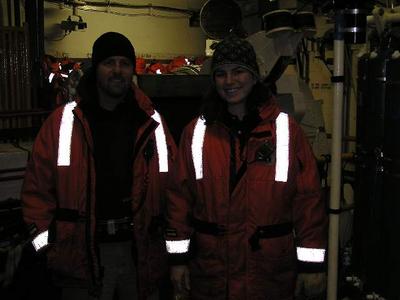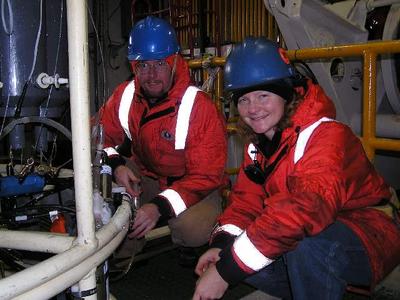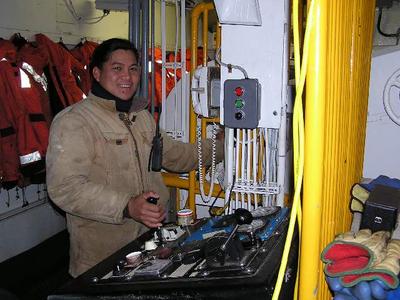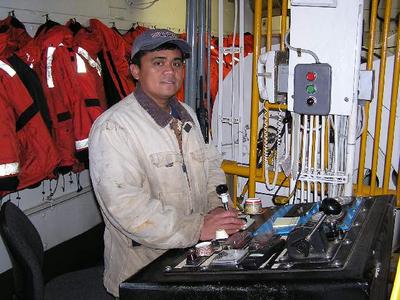
|
|
28 July, 2003
There was a glitch or two, but scientific progress marches on. It
didnít seem that way, however, for a few hours this evening.
During a routine cast of the CTD/rosette, an alarm sounded-off
alerting us that the CTD was too close to the bottom. Normally
thatís a good thing because you donít ever want the rosette to strike
the bottom which can damage the CTD. The problem was this: the
rosette was 1250 meters above the bottom. Indeed, the CTD warning
alarm isnít suppose to activate until itís within 20 meters of the
sea-floor. So this was interesting.
Graduate student, Craig Aumack, who was directing the cast, consulted
with Scrippsís electronics technician Rob Palomares, and subsequently
instructed the winch operator, Danny Plaza, to retrieve the rosette.
After a quick inspection by Rob, and electronic technician Brent
Evers, marine tech Jenny White, and Dr. Karl Newyear, Craig was given
the green light to repeat the cast.
All seemed to be going well until an identical error occurred and the
cast had to be aborted again. Now it was puzzling.
Rob, Brent, Jenny, and Karl took an even closer look, and when all
seemed fine, a third cast commenced. By this time a new winch
operator, Ricky Alvezo, began his shift. And Craig was joined by
graduate student Jeremy Mathis and Chief Scientist, Jim Swift in the
lab. Everything worked well going down, and three water samples were
taken before the rosette completely lost power and failed to transmit
data on its return to the surface. It was time to get serious.
Eventually, Rob, Brent, and Gerry Bucher (another electronics
technician) determined that there was an electrical short, and
possibly a blown fuse, which made it necessary to replace the CTD on
the rosette. (The ship carries two spare CTDs.) A couple of new
sensor cables were installed too. And for good measure, the last 50
meters of the big cable that attaches the CTD/rosette to the winch
was removed by marine technicians Emily Constantine and Jesse Doren
(who relieved Jenny and Karl). Over a period of time, the end of the
cable gets stressed and becomes work-hardened, making it less
flexible, so every so often, it has to be ďre-terminated,Ē or
replaced. Finally, the cast was successfully executed.
Plainly put, it was fascinating to observe all the teamwork and
trouble-shooting employed by everyone involved. And Iím pleased to
report that the CTD has worked just fine ever since.
As I mentioned before, glitch by glitch, science goes on.

Scripps's electronics technician, Rob Palomares.

Marine technicians Jesse Doren and Emily Constantine.

Karl Newyear and Jenny White working on the CTD.

Winch Operator Enrique (Ricky) Alvezo.

Winch Operator Danilo (Danny) Plaza.
Contact the TEA in the field at
.
If you cannot connect through your browser, copy the
TEA's e-mail address in the "To:" line of
your favorite e-mail package.
|
